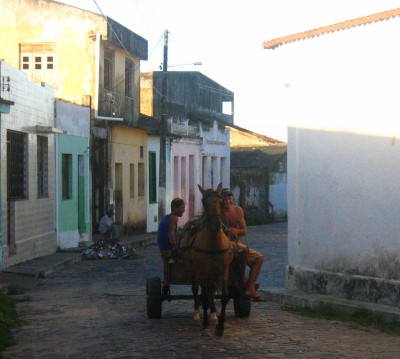Recife, Brazil
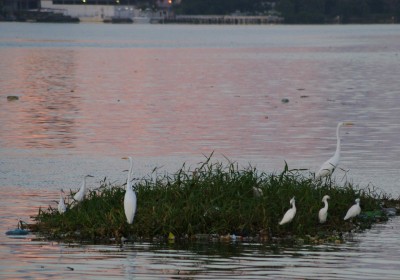 Little floating clumps of weed that drift back and forth with the tide frequently hold birds in Recife harbor.
Little floating clumps of weed that drift back and forth with the tide frequently hold birds in Recife harbor.
Monthly Archives: May 2009
Birds
Recife, Brazil
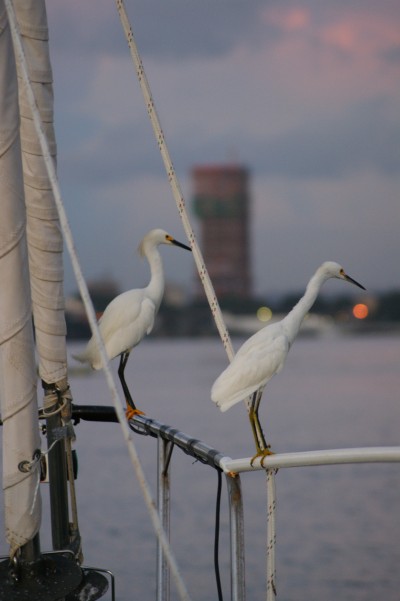 There are lots of these birds in Recife Harbor.
There are lots of these birds in Recife Harbor.
Drying out
Porto do Suape, PE, Brazil
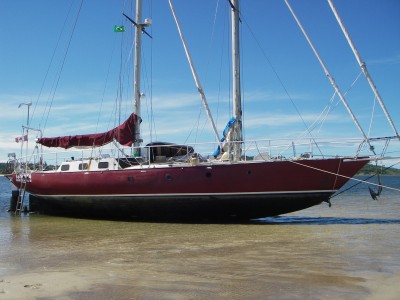 I needed to do some work on the propellers (change and inspect the anodes), which was much easier to do with them out of the water. I took the boat about 20 miles south of Recife to Porto do Suape. There is a significant commercial harbor there, as well as a very shallow, sandy harbor, where I wanted to beach the boat near high tide so the propellers would be out of the water at low tide. There is a pleasant village in the shallow harbor.The shallow part of Suape being, well, shallow, I went aground about ten times on the way in…much of the time staying about 10 metres off a reef, where the deepest water was, for two miles. All the groundings were on sand, and the tide was rising, so none were a problem–just lift the keel a little more and proceed. While doing all this running aground I realized that not always does just lifting the keel free you from the bottom, as lifting the keel also means the weight of the keel is no longer partly supported by the bottom, so the hull floats a bit lower as the keel is raised–this is only an issue when the keel is almost all the way up. The workaround, of course, is to ensure you only go aground on a rising tide, as you would do without a lifting keel :). The tidal range was about 1.6m, so the boat always remained partly in the water, but it was far enough out of the water to easily work on the propellers.
I needed to do some work on the propellers (change and inspect the anodes), which was much easier to do with them out of the water. I took the boat about 20 miles south of Recife to Porto do Suape. There is a significant commercial harbor there, as well as a very shallow, sandy harbor, where I wanted to beach the boat near high tide so the propellers would be out of the water at low tide. There is a pleasant village in the shallow harbor.The shallow part of Suape being, well, shallow, I went aground about ten times on the way in…much of the time staying about 10 metres off a reef, where the deepest water was, for two miles. All the groundings were on sand, and the tide was rising, so none were a problem–just lift the keel a little more and proceed. While doing all this running aground I realized that not always does just lifting the keel free you from the bottom, as lifting the keel also means the weight of the keel is no longer partly supported by the bottom, so the hull floats a bit lower as the keel is raised–this is only an issue when the keel is almost all the way up. The workaround, of course, is to ensure you only go aground on a rising tide, as you would do without a lifting keel :). The tidal range was about 1.6m, so the boat always remained partly in the water, but it was far enough out of the water to easily work on the propellers.
Recife Ferry
Recife, Brazil
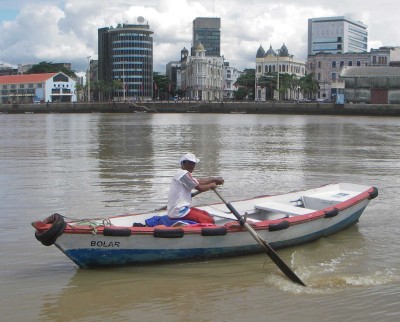 This is one of the dozen or so ferries that take people across Recife harbor. Two have outboards (one of which is reliable, one isn’t), the rest are solely powered by oars. One day, on a trip across in the ferry with the unreliable outboard, I had the opportunity to row the boat while the owner was cleaning the spark plug to get the engine restarted. The engine did restart, but I’d rowed to the other side by the time it did. The boats are relatively heavy, flat-bottomed wooden boats, and row slowly but surely.
This is one of the dozen or so ferries that take people across Recife harbor. Two have outboards (one of which is reliable, one isn’t), the rest are solely powered by oars. One day, on a trip across in the ferry with the unreliable outboard, I had the opportunity to row the boat while the owner was cleaning the spark plug to get the engine restarted. The engine did restart, but I’d rowed to the other side by the time it did. The boats are relatively heavy, flat-bottomed wooden boats, and row slowly but surely.
Recife Ferry oar detail
Recife, Brazil
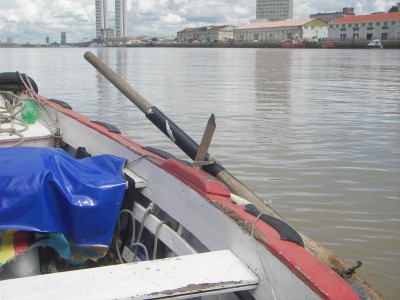 No oarlocks, thole pins (sticks of wood) are used instead. The rope that holds the oar to the thole pin goes around the side of the thole pin facing away from the rower. The black piece on the oar is a length of plastic pipe for chafe protection. The white on the black is just some spilled paint.The blades of the oars tend to be bolted to the shaft of the oars with a couple of stainless steel bolts.
No oarlocks, thole pins (sticks of wood) are used instead. The rope that holds the oar to the thole pin goes around the side of the thole pin facing away from the rower. The black piece on the oar is a length of plastic pipe for chafe protection. The white on the black is just some spilled paint.The blades of the oars tend to be bolted to the shaft of the oars with a couple of stainless steel bolts.
Recife Approach
Recife, Brazil
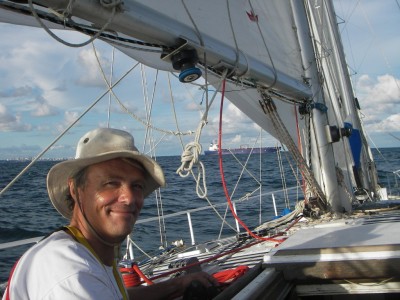 Recife, just visible in the background, is laid out as a long city, running for several miles along the beach.
Recife, just visible in the background, is laid out as a long city, running for several miles along the beach.
Umbrella Boat
Recife, Brazil
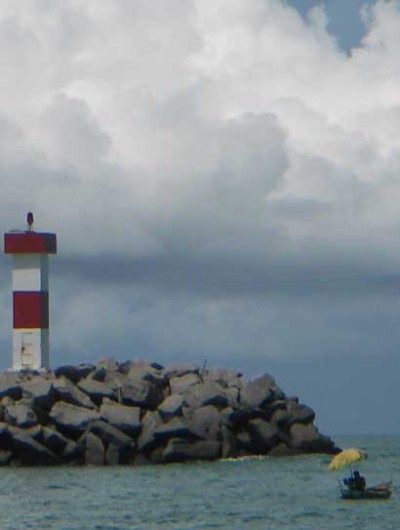 I guess putting a big umbrella on a boat is a good, cheap way to stay cool in the tropical sun. This was taken in the entrance to Recife harbor.
I guess putting a big umbrella on a boat is a good, cheap way to stay cool in the tropical sun. This was taken in the entrance to Recife harbor.
Working Sailboat in Recife
Recife, Brazil
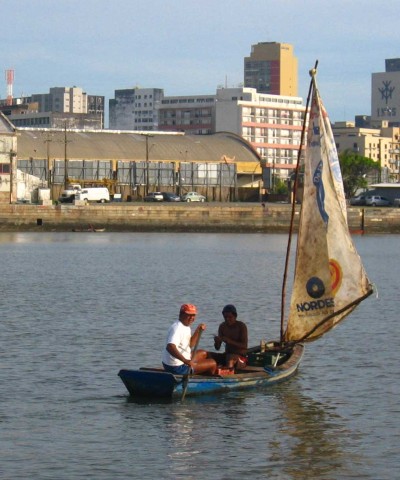 This is a working sailboat in Recife harbor. Many similar rowboats are used for fishing here. They fish mostly by casting nets. Few of the rowboats have added a sail, like this one did. The rowboats are simple, wooden, flat-bottom craft.
This is a working sailboat in Recife harbor. Many similar rowboats are used for fishing here. They fish mostly by casting nets. Few of the rowboats have added a sail, like this one did. The rowboats are simple, wooden, flat-bottom craft.
Recife Lighthouse
Recife, Brazil
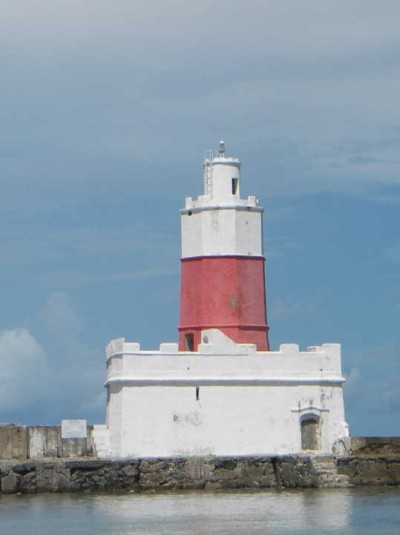 This is the lighthouse at Recife. Recife, a city of 3.6 million people in the northeast of Brazil, has a harbor that is well-protected by an outer reef. It was an easy, four-day sail from Salvador to Recife.
This is the lighthouse at Recife. Recife, a city of 3.6 million people in the northeast of Brazil, has a harbor that is well-protected by an outer reef. It was an easy, four-day sail from Salvador to Recife.
Maragojiipe street scene
Maragojiipe, Bahia, Brasil
